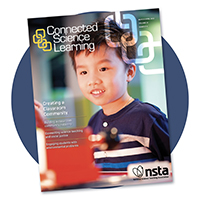Author Guidelines
Connected Science Learning

Connected Science Learning
The primary audience of Connected Science Learning is STEM learning professionals, especially practitioners with responsibility for program development, in both in-school and out-of-school science learning environments (ranging from schools to museums, afterschool programs, media and technology experiences, and home and family learning).
Questions?
Contact managing editor Valynda Mayes at vmayes@nsta.org.
Audience
STEM learning professionals
University faculty
State and district supervisors and leaders
Schedule
Six issues per year
Formats
e-journal
Manuscript
Create
Create a Manuscript
We seek manuscripts that clearly show how program development included extensive collaboration between in-school and out-of-school STEM learning settings, including co-creation of programs when possible.
We Publish...
Acceptable submissions must include most, if not all, of the following elements:
-
Clearly show how program development included extensive collaboration between in-school and out-of-school STEM learning settings, including co-creation of programs when possible.
-
Thoroughly describe practical and successful connected STEM learning program ideas and strategies that appeal to a wide audience and are applicable to the readership of Connected Science Learning, including detailed examples of key program elements.
-
Provide outcomes from the program's evaluation.
-
Include examples of youth experiences and interactions that demonstrate your manuscript is an authentic, connected experience involving in-school and out-of-school learning. Manuscripts should identify the target age of the youth involved in your collaboration.
-
Provide recommendations regarding how the program ideas and strategies can be adopted/adapted by others.
-
Provide examples of what may have gone wrong, unexpected results, and unforeseen challenges.
-
Include support for claims made in the manuscript, including research citations and personal anecdotal evidence.
-
Suggest additional supplemental material that can be embedded in the publication, including videos, podcasts, and websites.
-
Demonstrate that youth engaged in STEM learning are operating in a safe environment—see NSTA's safety in the learning environment standards.
We Do NOT Publish...
We do not publish feature articles that
-
Do not include activities that bridge between in-school and out-of-school STEM learning.
-
Have been previously published in either print or digital format (e.g., websites, blogs, e-books). Supplemental material that has been published before (e.g., websites, blogs, e-books) are acceptable and encouraged.
-
Focus on research without providing the practical details necessary for the application of the ideas.
-
Contain material that is not original, or do not provide a unique, proven approach to a typical in-school/out-of-school collaboration.
-
Are strictly opinions, a personal rather than professional experience, travelogues, personal reflections, or diary-type submissions.
-
Are term papers, dissertations, university writing assignments, lists of ideas, or materials reviews.
-
Promote a commercial product such as materials, books, software, or professional services.
Questions?
If you have any questions about the submission process, please contact the CSL editor by email.
Valynda Mayes, Managing Editor


